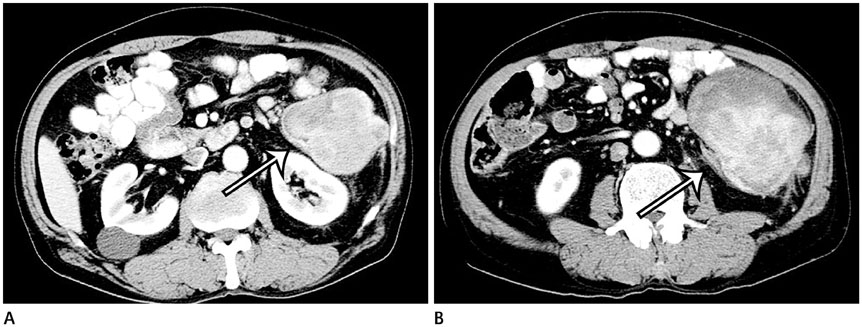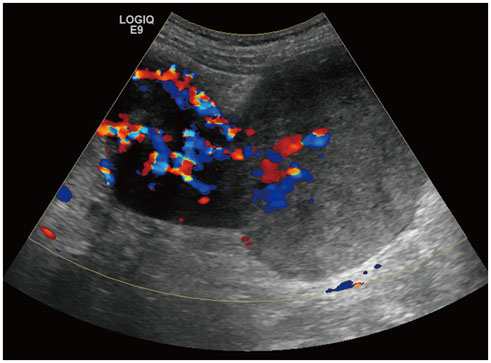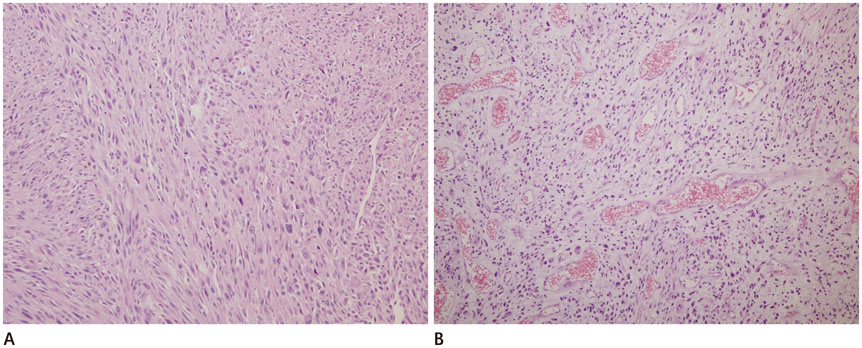J Korean Soc Radiol.
2017 Apr;76(4):245-250. 10.3348/jksr.2017.76.4.245.
Imaging Findings of Leiomyosarcoma Arising from the Descending Colon Which Presented as a Large Mass in the Retroperitoneum: A Case Report
- Affiliations
-
- 1Department of Radiology, Wonkwang University School of Medicine, Wonkwang University Hospital, Iksan, Korea. yjyh@wonkwang.ac.kr
- 2Department of Pathology, Wonkwang University School of Medicine, Wonkwang University Hospital, Iksan, Korea.
- KMID: 2373960
- DOI: http://doi.org/10.3348/jksr.2017.76.4.245
Abstract
- Leiomyosarcoma is a malignant tumor of smooth muscle cells and it usually originates from the uterus and the retroperitoneum. Leiomyosarcoma of the gastrointestinal tract is rare and leiomyosarcoma of the colon in even more rare, accounting for less than 0.1% of all colonic malignancies. It can be difficult to differentiate leiomyosarcoma from tumor of the retroperitoneum, especially if the mass invades both the colon and the retroperitoneum. We describe the imaging findings of a primary leiomyosarcoma of the descending colon which manifested as a palpable mass in the left lower quadrant of the abdomen and was diagnosed to be of colonic origin by identifying supply vessels of the mass on imaging studies, and the diagnosis was confirmed by surgicopathologic findings.
MeSH Terms
Figure
Reference
-
1. Cho SH, Lee JH, Choi SR, Baek YH, Yoon HA, Lee CJ, et al. A case of leiomyosarcoma of the sigmoid colon presenting as intussusception. Korean J Gastrointest Endosc. 2010; 40:270–274.2. Iwasa K, Taniguchi K, Noguchi M, Yamashita H, Kitagawa M. Leiomyosarcoma of the colon presenting as acute suppurative peritonitis. Surg Today. 1997; 27:337–344.3. Ouh YT, Hong JH, Min KJ, So KA, Lee JK. Leiomyosarcoma of the rectum mimicking primary ovarian carcinoma: a case report. J Ovarian Res. 2013; 6:27.4. Warkel RL, Stewart JB, Temple AJ. Leiomyosarcoma of the colon: report of a case and analysis of the relationship of histology to prognosis. Dis Colon Rectum. 1975; 18:501–506.5. O'Sullivan PJ, Harris AC, Munk PL. Radiological imaging features of non-uterine leiomyosarcoma. Br J Radiol. 2008; 81:73–81.6. Lee SH, Ha HK, Byun JY, Kim AY, Cho KS, Lee YR, et al. Radiological features of leiomyomatous tumors of the colon and rectum. J Comput Assist Tomogr. 2000; 24:407–412.7. van den Berg JC, van Heesewijk JP, van Es HW. Malignant stromal tumour of the rectum: findings at endorectal ultrasound and MRI. Br J Radiol. 2000; 73:1010–1012.8. Petscavage-Thomas JM, Walker EA, Logie CI, Clarke LE, Duryea DM, Murphey MD. Soft-tissue myxomatous lesions: review of salient imaging features with pathologic comparison. Radiographics. 2014; 34:964–980.9. Nishino M, Hayakawa K, Minami M, Yamamoto A, Ueda H, Takasu K. Primary retroperitoneal neoplasms: CT and MR imaging findings with anatomic and pathologic diagnostic clues. Radiographics. 2003; 23:45–57.10. Lee WK, Lau EW, Duddalwar VA, Stanley AJ, Ho YY. Abdominal manifestations of extranodal lymphoma: spectrum of imaging findings. AJR Am J Roentgenol. 2008; 191:198–206.







